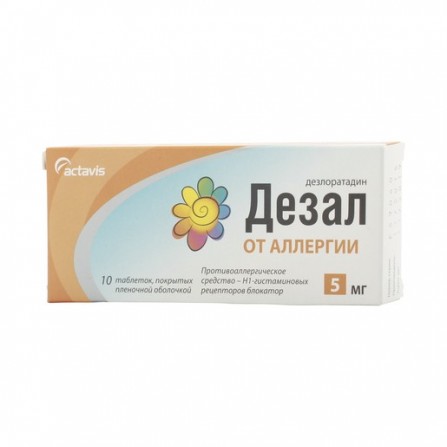More info
Active ingredients
Desloratadine
Release form
Pills
Composition
1 tablet contains: Active substance: desloratadine 5 mg. Adjuvants: microcrystalline cellulose, pregelatinized corn starch, mannitol, talc, magnesium stearate
Pharmacological effect
Desal - antiallergic agent - histamine H1 receptor blocker. Long-acting antihistamine preparation, peripheral histamine H1 receptor blocker. Desloratadine is the primary active metabolite of loratadine. Inhibits a cascade of reactions of allergic inflammation, incl. release of pro-inflammatory cytokines including the interleukins IL-4, IL-6, IL-8, IL-13, the release of proinflammatory chemokines superoxide anion production by activated polymorphonuclear neutrophils adhesion and chemotaxis eosinophils selection adhesion molecules such as P-selectin, IgE- mediated release of histamine, prostaglandin D2 and leukotriene C4. Thus, it prevents the development and facilitates the course of allergic reactions, has antipruritic and anti-exudative action, reduces the permeability of the capi lyarov, prevents the development of edema, spasm of smooth muskulatury.Preparat no effect on the CNS, substantially no sedative effect (does not cause drowsiness) and does not affect the speed of psychomotor reactions when taken in recommended doses. Does not cause lengthening of the QT interval on the ECG. The action of desloratadine begins within 30 minutes after ingestion and lasts for 24 hours.
Pharmacokinetics
AbsorptionAfter taking the drug inside desloratadine well absorbed from the gastrointestinal tract. Determined in blood plasma after 30 min, and Cmax is reached in approximately 3 hours. No clinically significant changes in plasma concentration of desloratadine were observed upon repeated administration of ketoconazole and erythromycin. The bioavailability of desloratadine is proportional to the dose when taking a dose in the range from 5 mg to 20 mg. Distribution Binding to plasma proteins is 83-87%. When used in adults and adolescents for 14 days at a dose of 5 mg to 20 mg 1 time / day, there is no evidence of clinically significant cumulation of desloratadine. The degree of cumulation of desloratadine is consistent with the value of T1 / 2 and the frequency of its use 1 time / day.The AUC and Cmax values in children were similar to those in adults who received 5 mg of desloratadine. Simultaneous ingestion of food or grapefruit juice does not affect the distribution of desloratadine (when taken in a dose of 7.5 mg 1 time / day). Does not penetrate through the BBB. Metabolism The enzymes responsible for the metabolism of desloratadine are not yet known; therefore, interactions with certain drugs cannot be completely ruled out. It is not an inhibitor of CYP3A4 and CYP2D6 and is not a substrate or inhibitor of P-glycoprotein. It is extensively metabolized in the liver by hydroxylation to form 3-OH-desloratadine, which then glucuronizes. Excretion The T1 / 2 terminal phase is about 27 hours. Desloratadine is eliminated from the body in the form of a glucuronide compound and in a small amount in an unchanged form (with urine less than 2% and through the intestines - less than 7%).
Indications
To alleviate or eliminate the symptoms: allergic rhinitis (sneezing, nasal congestion, rhinorrhea, itching of the nose, itching of the palate, itching and redness of the eyes, tearing), urticaria (skin itching, rash).
Contraindications
- hypersensitivity to the active or any auxiliary substance of the drug; - pregnancy; - breastfeeding period; - age up to 12 years (efficacy and safety have not been established); With caution should use the drug in severe renal failure.
Use during pregnancy and lactation
Purpose of the drug during pregnancy is not recommended due to the lack of clinical data on the safety of its use in this period. Desloratadine is excreted in breast milk, so its use during breastfeeding is not recommended.
Dosage and administration
Inside, regardless of the meal. Adults and adolescents (12 years and older) - 5 mg (1 tablet) 1 time per day.
Side effects
The following adverse reactions are most frequently noted: increased fatigue (1.2%), dryness of the oral mucosa (0.8%), headache (0.6%). When using the drug in adults and adolescents at the recommended dose of 5 mg / drowsiness rate is not higher, than with placebo. The following adverse reactions were very rarely observed during post-marketing follow-up. Mental disorders: hallucinations. On the CNS side: dizziness, drowsiness,insomnia, psychomotor hyperactivity. On the part of the cardiovascular system: tachycardia, feeling of heartbeat. On the part of the digestive system: abdominal pain, nausea, vomiting, dyspepsia, diarrhea. Hepatitis. From the musculoskeletal system: myalgia. Allergic reactions: anaphylaxis, angioedema, pruritus, rash, urticaria.
Overdose
Symptoms: Reception at a dose in excess of the recommended 9 times (45 mg) did not lead to the appearance of any clinically significant symptoms. Drowsiness may develop. Treatment: gastric lavage, taking activated carbon; if necessary, symptomatic therapy. Desloratadine is not excreted by hemodialysis, the effectiveness of peritoneal dialysis has not been established.
Interaction with other drugs
No clinically significant interaction with other drugs was found (including with ketoconazole and erythromycin). Desloratadine does not enhance the effect of ethanol on the central nervous system.
special instructions
In the case of pronounced impaired renal function, Desal should be taken with caution. In studies, no effect of desloratadine on driving has been observed. However, it should be borne in mind that it is very rare for some patients to develop drowsiness, in this case care should be taken when driving and working with mechanisms.





